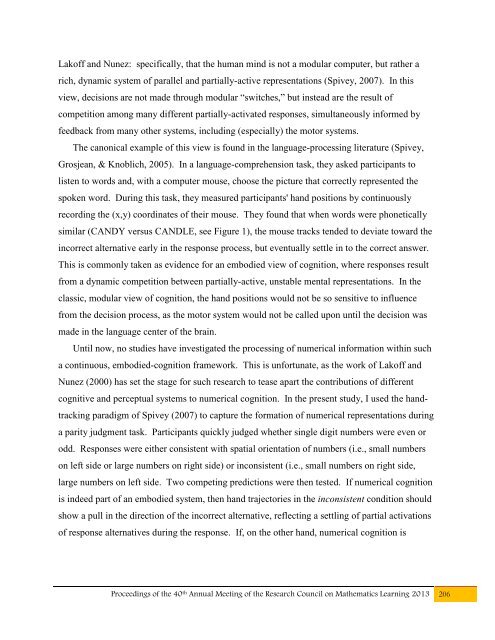2013 Conference Proceedings - University of Nevada, Las Vegas
2013 Conference Proceedings - University of Nevada, Las Vegas
2013 Conference Proceedings - University of Nevada, Las Vegas
- No tags were found...
Create successful ePaper yourself
Turn your PDF publications into a flip-book with our unique Google optimized e-Paper software.
Lak<strong>of</strong>f and Nunez: specifically, that the human mind is not a modular computer, but rather arich, dynamic system <strong>of</strong> parallel and partially-active representations (Spivey, 2007). In thisview, decisions are not made through modular “switches,” but instead are the result <strong>of</strong>competition among many different partially-activated responses, simultaneously informed byfeedback from many other systems, including (especially) the motor systems.The canonical example <strong>of</strong> this view is found in the language-processing literature (Spivey,Grosjean, & Knoblich, 2005). In a language-comprehension task, they asked participants tolisten to words and, with a computer mouse, choose the picture that correctly represented thespoken word. During this task, they measured participants' hand positions by continuouslyrecording the (x,y) coordinates <strong>of</strong> their mouse. They found that when words were phoneticallysimilar (CANDY versus CANDLE, see Figure 1), the mouse tracks tended to deviate toward theincorrect alternative early in the response process, but eventually settle in to the correct answer.This is commonly taken as evidence for an embodied view <strong>of</strong> cognition, where responses resultfrom a dynamic competition between partially-active, unstable mental representations. In theclassic, modular view <strong>of</strong> cognition, the hand positions would not be so sensitive to influencefrom the decision process, as the motor system would not be called upon until the decision wasmade in the language center <strong>of</strong> the brain.Until now, no studies have investigated the processing <strong>of</strong> numerical information within sucha continuous, embodied-cognition framework. This is unfortunate, as the work <strong>of</strong> Lak<strong>of</strong>f andNunez (2000) has set the stage for such research to tease apart the contributions <strong>of</strong> differentcognitive and perceptual systems to numerical cognition. In the present study, I used the handtrackingparadigm <strong>of</strong> Spivey (2007) to capture the formation <strong>of</strong> numerical representations duringa parity judgment task. Participants quickly judged whether single digit numbers were even orodd. Responses were either consistent with spatial orientation <strong>of</strong> numbers (i.e., small numberson left side or large numbers on right side) or inconsistent (i.e., small numbers on right side,large numbers on left side. Two competing predictions were then tested. If numerical cognitionis indeed part <strong>of</strong> an embodied system, then hand trajectories in the inconsistent condition shouldshow a pull in the direction <strong>of</strong> the incorrect alternative, reflecting a settling <strong>of</strong> partial activations<strong>of</strong> response alternatives during the response. If, on the other hand, numerical cognition is<strong>Proceedings</strong> <strong>of</strong> the 40 th Annual Meeting <strong>of</strong> the Research Council on Mathematics Learning <strong>2013</strong> 206




